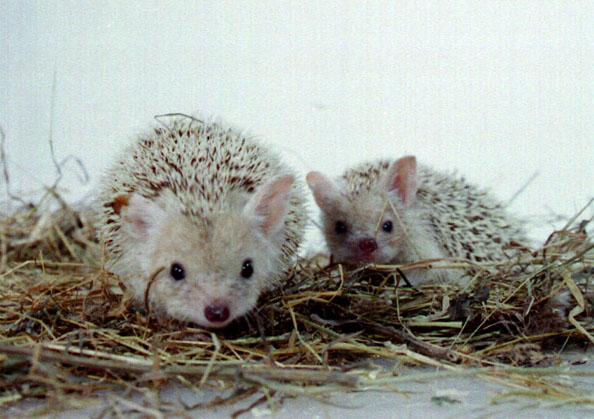If you cannot find the answer you are looking for, please contact us.
Long-eared hedgehog

First described in 1770 by Gmelin. It is instantly recognisable by its unusually large ears, which help with heat regulation and acute hearing in arid environments. It is one of the few non-domesticated hedgehog species regularly kept as a pet.
Taxonomy
| Kingdom: | Animalia |
| Phylum: | Chordata |
| Class: | Mammalia |
| Order: | Eulipotyphla |
| Family: | Erinaceidae |
| Genus: | Hemiechinus |
| Species: | Hemiechinus auritus |
Natural range & habitat
The Long-eared Hedgehog is native to a wide range extending from Eastern Europe through the Middle East and Central Asia into parts of western China and Mongolia. It inhabits arid and semi-arid environments, including deserts, steppes, and dry grasslands, but it can also be found in agricultural areas, oases, and the outskirts of villages. It prefers open terrain with sparse vegetation and sandy or soft soil suitable for digging burrows. Within its range, it is adaptable to a variety of climates, from hot lowland deserts to cooler highland steppes, though it avoids dense forests and wetlands.
Physical traits
The Long-eared Hedgehog is a small to medium-sized hedgehog, typically 12 to 27 centimeters in length and weighing between 250 and 500 grams. Its most distinctive feature is its large ears, which can measure up to 4 centimeters in length and serve as an adaptation for thermoregulation and enhanced hearing in open habitats. The spines are generally pale or sandy with darker tips, providing camouflage in its arid environment. The underbelly fur is light-colored, usually cream or white, and the face is pointed with a long snout. Legs are relatively long compared to other hedgehogs, aiding in faster movement across open terrain. Seasonal weight gain occurs prior to hibernation in colder regions.
Behavior & lifestyle
The Long-eared Hedgehog is nocturnal and solitary, emerging at night to forage and retreating to burrows during the day. It is a skilled digger, capable of creating extensive burrow systems for shelter, breeding, and hibernation. In the northern parts of its range, it hibernates during winter, while in extremely hot regions it may enter aestivation during peak summer heat. It is more mobile and faster-moving than many other hedgehog species, likely due to its lighter build and long limbs. Home range size varies depending on habitat and food availability, and individuals actively avoid one another outside of the breeding season.
Communication
Communication in the Long-eared Hedgehog is primarily olfactory, using scent marking for territory delineation and reproductive signaling. Acoustic communication includes hisses, grunts, and clicking sounds, especially during mating interactions or when threatened. Its large ears may play a role in detecting low-frequency sounds from predators or prey, though this has not been studied in detail. Self-anointing behavior, common to many hedgehogs, has been observed in this species, often after encountering strong-smelling substances, though the exact function remains uncertain.
Diet in the wild
The Long-eared Hedgehog is an opportunistic insectivore with a diet consisting primarily of beetles, ants, grasshoppers, and other invertebrates. It may also eat small vertebrates such as lizards, frogs, and rodents, along with bird eggs. Plant matter is consumed occasionally but forms a minor part of the diet. In dry environments, it relies heavily on prey with high water content to meet its hydration needs. Foraging is done on the ground, often involving digging in loose soil or leaf litter to uncover hidden prey. It has been recorded traveling considerable distances in a single night in search of food.
Reproduction & life cycle
Breeding generally occurs in spring and early summer. Courtship involves circling, vocalizations, and scent-based cues. Gestation lasts approximately 35 to 40 days, and females give birth to litters of two to six hoglets. The young are born blind and with soft spines, which harden within a few days. Eyes open around two weeks, and weaning occurs at four to six weeks. In favorable conditions, females may raise a second litter within the same breeding season. Sexual maturity is typically reached within the first year. In the wild, the species is thought to live three to five years, though in captivity it can live longer under optimal care.
Threats & conservation status
The Long-eared Hedgehog is classified as Least Concern by the IUCN due to its wide range and stable population. However, local threats include habitat loss from agriculture and urban development, road mortality, and predation by domestic animals. The use of pesticides can reduce prey availability and pose risks through secondary poisoning. In parts of its range, individuals are captured for the pet trade or killed due to cultural beliefs. Climate change may affect regional populations by altering prey abundance and habitat quality, but the long-term impacts are not yet fully understood.
This species in captivity
The Long-eared Hedgehog is one of the non-domesticated hedgehog species kept in captivity, with all individuals in the current captive population descending from wild-caught animals imported between roughly 2000 and 2010. Although they are no longer imported in significant numbers, and most individuals now in captivity are captive-bred, the species is still considered non-domesticated due to its short history under human care. This means they retain strong wild instincts and are generally less tolerant of handling than domesticated hedgehog breeds such as the African Pygmy Hedgehog (Atelerix albiventris). In captivity, they require a warm, dry environment, plenty of space for nocturnal activity, and environmental enrichment that allows for digging and hiding, as these behaviors are essential to their welfare. Their diet must be varied and insect-rich to mimic natural feeding ecology. While they can adapt to captivity, inadequate housing, improper diet, and lack of environmental complexity often lead to stress and health issues. They should be housed alone due to their solitary nature. With proper care, they can live several years in captivity, but they remain best suited to experienced exotic mammal keepers who can meet their specialized needs.
